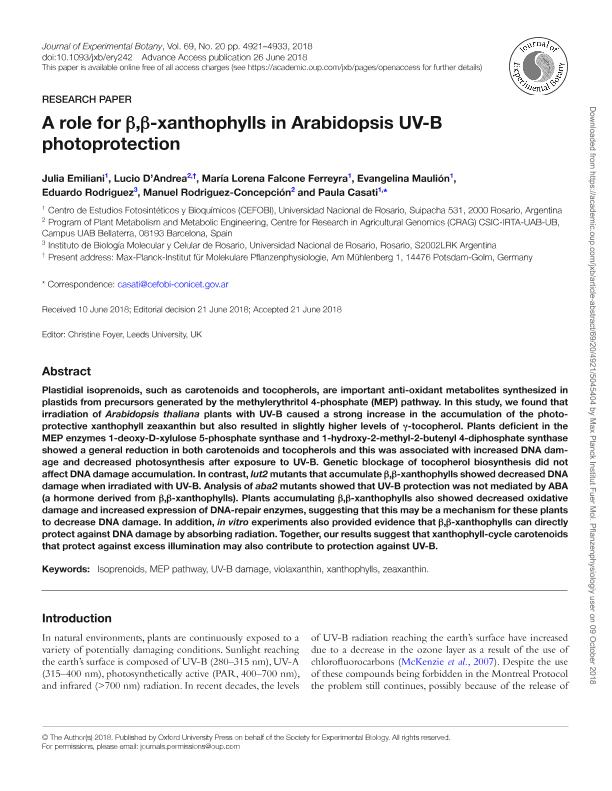Artículo
A role for β,β-xanthophylls in Arabidopsis UV-B photoprotection
Emiliani, Julia ; D'andrea, Lucio Jesus; Falcone Ferreyra, María Lorena
; D'andrea, Lucio Jesus; Falcone Ferreyra, María Lorena ; Maulión, Evangelina
; Maulión, Evangelina ; Rodriguez, Eduardo Jose
; Rodriguez, Eduardo Jose ; Rodriguez Concepción, Manuel; Casati, Paula
; Rodriguez Concepción, Manuel; Casati, Paula
 ; D'andrea, Lucio Jesus; Falcone Ferreyra, María Lorena
; D'andrea, Lucio Jesus; Falcone Ferreyra, María Lorena ; Maulión, Evangelina
; Maulión, Evangelina ; Rodriguez, Eduardo Jose
; Rodriguez, Eduardo Jose ; Rodriguez Concepción, Manuel; Casati, Paula
; Rodriguez Concepción, Manuel; Casati, Paula
Fecha de publicación:
09/2018
Editorial:
Oxford University Press
Revista:
Journal of Experimental Botany
ISSN:
0022-0957
e-ISSN:
1460-2431
Idioma:
Inglés
Tipo de recurso:
Artículo publicado
Clasificación temática:
Resumen
Plastidial isoprenoids, such as carotenoids and tocopherols, are important anti-oxidant metabolites synthesized in plastids from precursors generated by the methylerythritol 4-phosphate (MEP) pathway. In this study, we found that irradiation of Arabidopsis thaliana plants with UV-B caused a strong increase in the accumulation of the photoprotective xanthophyll zeaxanthin but also resulted in slightly higher levels of γ-tocopherol. Plants deficient in the MEP enzymes 1-deoxy-D-xylulose 5-phosphate synthase and 1-hydroxy-2-methyl-2-butenyl 4-diphosphate synthase showed a general reduction in both carotenoids and tocopherols and this was associated with increased DNA damage and decreased photosynthesis after exposure to UV-B. Genetic blockage of tocopherol biosynthesis did not affect DNA damage accumulation. In contrast, lut2 mutants that accumulate β,β-xanthophylls showed decreased DNA damage when irradiated with UV-B. Analysis of aba2 mutants showed that UV-B protection was not mediated by ABA (a hormone derived from β,β-xanthophylls). Plants accumulating β,β-xanthophylls also showed decreased oxidative damage and increased expression of DNA-repair enzymes, suggesting that this may be a mechanism for these plants to decrease DNA damage. In addition, in vitro experiments also provided evidence that β,β-xanthophylls can directly protect against DNA damage by absorbing radiation. Together, our results suggest that xanthophyll-cycle carotenoids that protect against excess illumination may also contribute to protection against UV-B.
Palabras clave:
ISOPRENOIDS
,
MEP PATHWAY
,
UV-B DAMAGE
,
VIOLAXANTHIN
,
XANTHOPHYLLS
,
ZEAXANTHIN
Archivos asociados
Licencia
Identificadores
Colecciones
Articulos(CEFOBI)
Articulos de CENTRO DE EST.FOTOSINTETICOS Y BIOQUIMICOS (I)
Articulos de CENTRO DE EST.FOTOSINTETICOS Y BIOQUIMICOS (I)
Citación
Emiliani, Julia; D'andrea, Lucio Jesus; Falcone Ferreyra, María Lorena; Maulión, Evangelina; Rodriguez, Eduardo Jose; et al.; A role for β,β-xanthophylls in Arabidopsis UV-B photoprotection; Oxford University Press; Journal of Experimental Botany; 69; 20; 9-2018; 4921-4933
Compartir
Altmétricas



